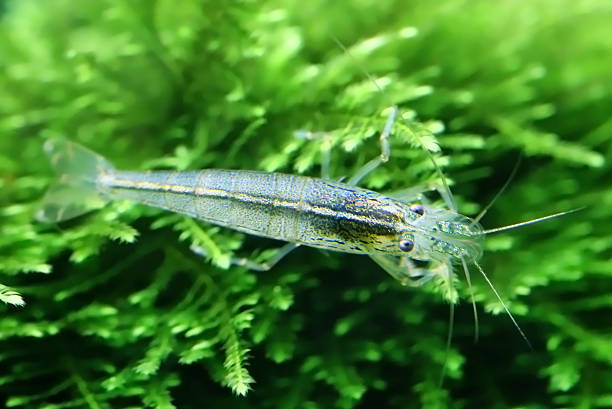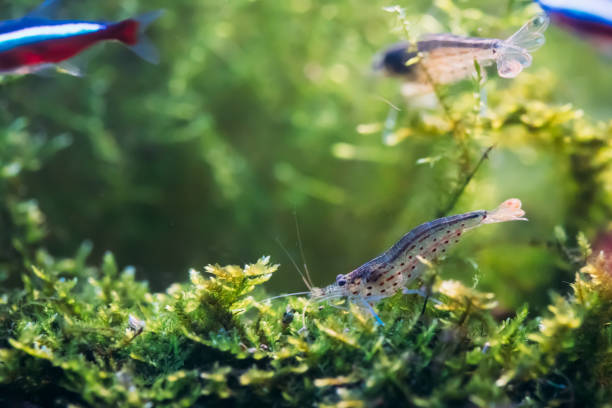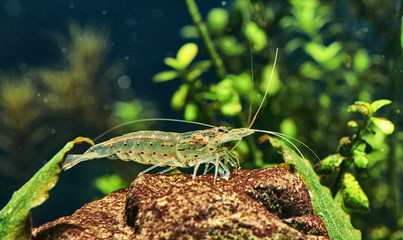Table of Contents
Scientific Classification
| Kingdom | Animalia |
| Phylum | Arthropoda |
| Class | Malacostraca |
| Order | Decapoda |
| Family | Atyidae |
| Genus | Caridina |
| Species | Caridina multidentata |
| Scientific Name | Caridina multidentata |
Description
Amano shrimp, also known as Yamato shrimp, are small freshwater crustaceans that are favored by aquarists for their excellent algae-eating abilities. Typically, these shrimp grow to about 5 cm (2 inches) in length. They feature a clear body adorned with brown or reddish spots on their sides. Their semi-transparent bodies provide effective camouflage, making it difficult for predators to detect them.
The aquarium trade was introduced to Amano shrimp by Takashi Amano, a renowned aquascapist, who demonstrated their effectiveness in keeping tanks clean. Unlike other ornamental shrimp, Amano shrimp are more active and resilient, often seen scurrying around in search of food.

Distribution
Amano shrimp are native to Japan, Taiwan, and parts of mainland Asia. They are often bred in captivity, but wild populations still live in their native area.
Habitat
Amano shrimp thrive in clean, well-oxygenated freshwater environments such as:
Rivers with rocky or sandy bottoms
Streams with moderate currents
Aquariums with stable water conditions
They like places with lots of aquatic plants, driftwood, and rocks. These features give them shelter and surfaces to find food.
Diet
Amano shrimp are omnivores and scavengers. This makes them great at cleaning algae in aquariums. Their diet consists of:
- Algae (including hair algae and biofilm)
- Decaying plant matter
- Leftover fish food
- Small organic debris
- Commercial shrimp pellets and wafers
If algae levels are low, you can add blanched veggies like zucchini or spinach. This will give them the nutrition they need.

Behavior
Amano shrimp are highly active and social creatures. Their behaviors include:
Constant foraging for food, often seen picking at surfaces
Peaceful interactions with tank mates
Occasionally forming small groups while feeding
Molting their exoskeleton as they grow
Amano shrimp are different from some shrimp species. They rarely show territorial behaviour. This allows them to live peacefully in community tanks.
Lifespan
The lifespan of an Amano shrimp ranges from 2 to 5 years under optimal conditions. Factors that influence their longevity include:
Water quality
Availability of food
Absence of predators
Stable water parameters
Proper care and a well-maintained tank can significantly extend their lifespan.
Reproduction and Lifecycle
Amano shrimp have a tricky reproductive cycle. This makes breeding them in captivity hard. The process involves:
Females carrying eggs for about five weeks
Eggs hatching into larvae rather than miniature shrimp
Larvae requiring brackish water to develop properly
Juveniles transitioning back to freshwater upon maturity
Most Amano shrimp in the pet trade are wild-caught. They are not captive-bred because of these challenges.

Predators
In the wild, Amano shrimp face threats from various predators, including:
Fish such as larger cichlids and bettas
Crabs and crayfish
Aquatic birds
In aquariums, keeping them with small, peaceful fish ensures their safety. Providing ample hiding spots also helps protect them from potential threats.
Adaptations
Amano shrimp have evolved several adaptations that help them survive:
Translucent body for camouflage
Strong swimmer capable of escaping predators
Hard exoskeleton that provides protection
Ability to molt and regenerate damaged limbs
Efficient scavengers that thrive on varied food sources
These adaptations make them highly resilient in both the wild and captivity.
Conservation Status
Amano shrimp are currently not considered endangered. They inhabit various locations within their natural environment. Nonetheless, pollution in their habitats and excessive collection for the pet trade pose threats to their populations.
To ensure their abundance in the wild, it is essential to protect natural ecosystems and adopt sustainable collection methods.ems and using sustainable collection practices help keep them plentiful in the wild.
Conclusion
Amano shrimp are fascinating and beneficial additions to aquariums. They are recognized for their algae-eating habits and peaceful nature. Their ability to adapt and resilience make them favorites among aquarists around the globe. While breeding them in captivity can be challenging, they remain sought after in the aquarium market. When provided with the appropriate environment, these small yet efficient cleaners can flourish, contributing to the balance of both natural and artificial ecosystems.



